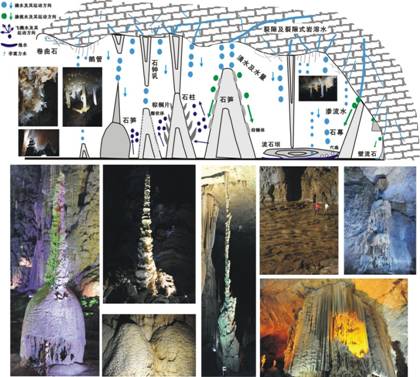Zhijindong Cave
Location:
Home
>
Geosites
> Zhijindong Cave
12-Landscape type and distribution of Zhijindong Cave
Timer:2015-03-25
There are mainly 5 types of cave landscapes in Zhijindong Cave: (1) Various secondary chemical sediments (i.e. stalactites); (2) Cave form (i.e. cave chamber); (3) Cave biotic deposits; (4) Cave collapsed landscape, (5) other cave landscapes.
Main stalactite types and their basic formation condition of Zhijindong Cave
| Types | Basic formation condition and development features | Distribution features | |
| 1-Dripstone | Soda straw | Karst water oozes along slim fissure on the vertical cave wall, forming a rudiment of stalactite | Mainly distributed in Crystal Palace |
| Stalactite | Karst water oozes along slim fissure on the vertical cave wall, forming dripping water. Different seepages forms different stalactites with different thickness, but in general, the stalactite is thick at the top and slim at the bottom, hanging on the cave wall vertically. | Distributed at many places in the cave with different sizes and scales, they are the most important and unique cave landscapes. | |
| Stalagmite | Karst water vertically oozes or flows along cave wall, forming stalagmites at the cave bottom corresponding to stalactites. Different seepages forms different stalagmites with different thickness, but in general, the stalagmite is slim at the top and thick at the bottom, vertical to the ground. | ||
| Column | It is formed through connection of stalactites developed at the top of cave wall and stalagmites developed at the bottom of cave. | ||
| 2-Flowstone | Wall flowstones (Curtains, draperies, stone waterfalls, cave flags, and shields): They flow out along the direction in parallel to or along the direction of the oblique crossing the cave wall, presenting linear, schistose and dispersed shapes. The shape and size of wall flowstones are subjected to the amount of flow, and most of them are of waterfall shape; the one which is wide, folded, thin and flag-shaped or strip-shaped is called cave flag or stone belt. | ||
| Flowstone dams: When karst water at the bottom of cave meets obstacles during its flowing process, supersaturated water sediments and separates out calcium carbonate continuously, forming a barrier to stop the water, and this kind of dam-shaped sediments is the flowstone dam. | |||
| 3-Pool water sediments | It sediments in water pool which is encircled by the flowstone dam, and the shapes of sediment change with sediment positions: rim stones are mosaic sediments at fixed boundary; cave pearls in different sizes are formed under the synergetic action of flowing water, pool water and dripping water. | Usually symbiotic developed with other stalactites, together forming colorful and beautiful stalactite landscape in the cave. | |
| 4-Splashing water sediments | The sediments formed by splashing water which is caused by suspended dripping water or flowing water under the fall condition are orderly distributed based on the sediment center and distribution radius. They usually coexist with stalagmites, columns, wall flowstone and other sediments on the cave wall. This kind of sediments in Zhijindong Cave is represented by spherical stalactite, palm slice, nodular body, and handlike stalactite, etc. | ||
| 5-Synergetic sediments | Cave pearls in different sizes are crystal sediments under the synergetic sedimentation of pool water, dripping water and flowing water. | ||
| Upward inclining palm slice is formed by combined sedimentation of dripping water and splashing water. | |||
| Fusiform curtains and columns are formed by synergetic sedimentation of dripping water and flowing water. | |||
| Various stalactites in special shapes are formed by synergetic sedimentation of dripping water, flowing water, splashing water and non-gravitational water, such as stalagmites in helmet shape and lampstand shape, columns in Chinese lute shape and draperies in helmet shape. | |||
| 6-Non-gravitational water sediments | It refers to stalactites formed under the action of capillary water and trace amount of water (such as film water). Stone hairs, helictites and coral-shaped products will be formed under high humidity condition, and nodular or ball-shaped stalactites and stone flowers will be formed under low humidity and relative dry condition. At present, these kinds of sediments found in Zhijindong Cave are helictites and stone flowers. | Helictites and stone flowers have been well developing in the Crystal Palace. | |
| 7-Heterogenetic-homomorphic sediments | Heterogenetic-homomorphic sediments like moonmilk, cave corals and crust-shaped products can be found in Zhijindong Cave; the moonmilk is quite rare in the caves both at home and abroad. | ||
| 8-Collapse sediments | It is formed by collapsing and accumulating, which is disorderly and densely packed; it is distributed at the bottom of all caves with different sizes. | ||

Sketch map of relationship among stalactite shapes and karst water seepage amount and seepage manner

















